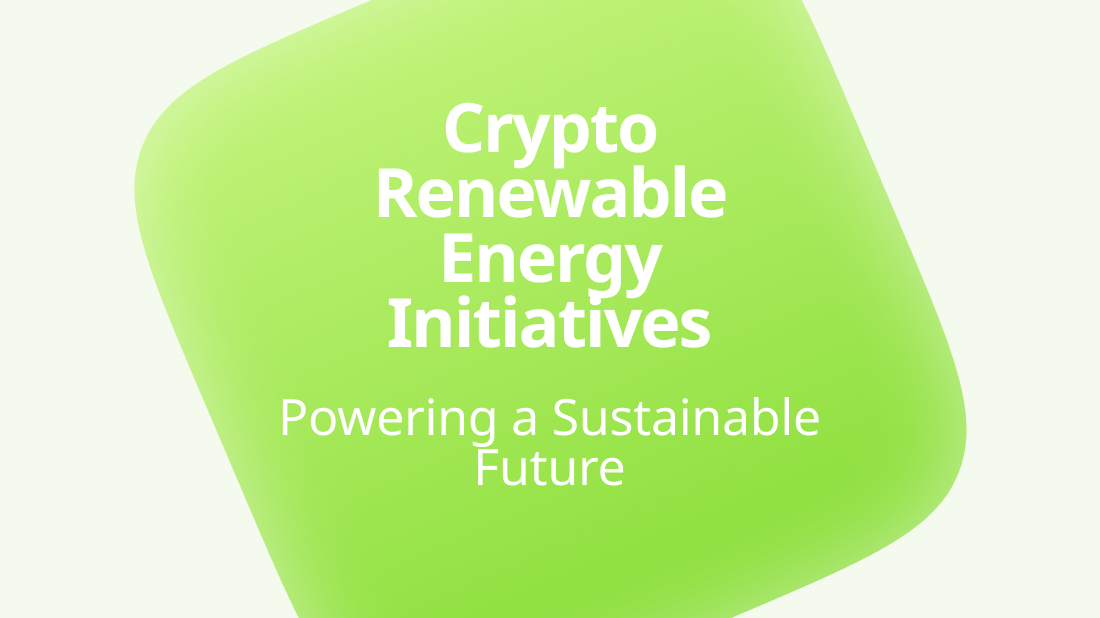Crypto Renewable Energy Initiatives: Powering a Sustainable Future

As cryptocurrencies gain mainstream traction, the environmental impact of crypto mining has come under scrutiny. Energy-intensive mining processes, especially those relying on Proof of Work (PoW) mechanisms, have significant carbon footprints. However, innovative blockchain projects are increasingly leveraging renewable energy sources to power their operations, promoting sustainability and environmental responsibility. This article delves into these pioneering initiatives and their potential to create a greener future for the crypto industry.
The Environmental Challenge of Crypto Mining
High Energy Consumption
Cryptocurrency mining, particularly Bitcoin mining, requires vast amounts of computational power, which translates to high energy consumption. The primary concern is that much of this energy comes from non-renewable sources, exacerbating carbon emissions and environmental degradation.
The Need for Sustainable Solutions
The crypto industry faces growing pressure to adopt sustainable practices. Green mining initiatives, which integrate renewable energy sources such as solar, wind, and hydropower, offer a promising solution to reduce the environmental impact of crypto mining.
Innovative Green Mining Projects
Project Highlight: SolarCoin
Solar-powered mining farms harness solar energy to power their operations. SolarCoin is a pioneering initiative that rewards solar energy producers with digital tokens. Each megawatt-hour of solar energy generated earns one SolarCoin, incentivizing solar energy production and offering a green alternative to traditional mining.
Project Highlight: WindMine
Wind-powered mining utilizes wind turbines to generate electricity for mining operations. WindMine, based in Northern Europe, combines wind energy with cryptocurrency mining. By leveraging the region's robust wind resources, WindMine aims to create a sustainable and profitable mining operation, contributing to local economies through job creation and renewable energy infrastructure support.
Project Highlight: BitRiver
Hydropower is a reliable source of renewable energy for crypto mining. BitRiver operates a large crypto mining data center in Russia, powered primarily by hydroelectric energy from the Bratsk Hydroelectric Power Station. This setup significantly reduces BitRiver's carbon footprint and ensures a stable energy supply.
Benefits of Renewable-Powered Crypto Mining
Environmental Impact
Green mining initiatives reduce reliance on fossil fuels and lower carbon emissions, aligning with global efforts to combat climate change and promoting the adoption of clean energy technologies.
Economic Advantages
Utilizing locally available renewable resources can reduce energy costs and increase profitability for mining operations. Additionally, these projects create job opportunities and stimulate economic growth in the renewable energy sector.
Regulatory Compliance and Public Perception
Adopting sustainable mining practices helps crypto projects comply with tightening environmental regulations. Demonstrating a commitment to environmental responsibility can enhance the public perception of the crypto industry and attract environmentally conscious investors.
Overcoming Challenges and Future Directions
Technical and Financial Hurdles
Despite the potential benefits, renewable-powered mining projects face challenges such as high initial setup costs and technical issues related to energy storage and grid integration. Continued innovation and collaboration within the industry are essential to address these challenges.
Innovations and Collaborations
Partnerships between crypto projects and renewable energy providers can facilitate the development of efficient and cost-effective green mining solutions. Advancements in energy storage technologies, such as battery systems and smart grids, can also enhance the viability of renewable-powered mining.
Policy and Advocacy
Supportive policies and incentives from governments and regulatory bodies can promote the adoption of renewable energy in the crypto industry. Subsidies, tax incentives, and research funding can encourage the development of green mining initiatives.
Conclusion
Crypto renewable energy initiatives are crucial for creating a sustainable and environmentally responsible future for the cryptocurrency industry. By integrating renewable energy sources into mining operations, these projects reduce carbon emissions, promote clean energy technologies, and contribute to economic growth. Embracing renewable energy not only mitigates the environmental impact of crypto mining but also sets a positive example for other industries. As the crypto community continues to evolve, adopting sustainable practices will be essential to address environmental concerns and ensure long-term viability.












